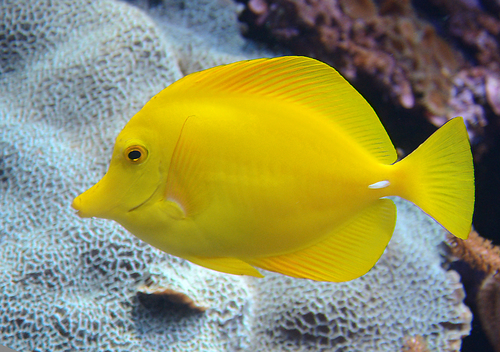
Yellow Tang
The Atlantic bluefin tuna (Thunnus thynnus) is a majestic and powerful fish, renowned for its size, speed, and long migrations. It plays a crucial role in the marine ecosystem and is highly prized in the culinary world. However, its popularity has led to significant conservation concerns.
5 30 years
Lifespan
20 cm
Length
Least Concern
Conservation Status
15 km/h
Swimming speed
Herbivorous
Diet
Local Migration
Migration
Appearance Overview
The Atlantic bluefin tuna is a large, torpedo-shaped fish with a metallic blue top and a silvery-white underside.
Coloration
Dark metallic blue above, silvery-white below
Body Shape
Torpedo-shaped and streamlined
Fins
Two dorsal fins, the first depressible; small finlets running from dorsal and anal fins to the tail
Length
Up to 13 feet (4 meters)
Weight
Up to 2,000 lbs (907 kg)
Diet
Carnivorous, feeding on fish, squid, crustaceans, and eels.
Feeding Behavior
Highly migratory, opportunistic predators that use their speed and agility to hunt. They are also known to feed cooperatively, herding prey together.
Social Behavior
Forms schools, often segregating by size. Highly migratory, traversing entire oceans.
Commercial Relevance
Extremely high value, particularly in the Japanese sushi and sashimi market. Overfishing has driven prices up, making it one of the most valuable fish species.
Conservation measures
Subject to international fishing quotas and management plans under organizations like ICCAT. Marine Protected Areas and fishing gear restrictions are also in place.
Status
Endangered (Varies by population segment; some are considered critically endangered)
Threats
Overfishing is the primary threat. Other factors include bycatch in fishing gear and, potentially, climate change affecting prey distribution.
Habitat Distribution
Depth Range
0-1,000 meters (typically found in the upper layers, but can dive deeper)
Geographic Range
Atlantic Ocean, Mediterranean Sea, and the Gulf of Mexico
Preferred Environment
Pelagic, open ocean waters; both temperate and tropical
Reproduction and Life Cycle
Breeding Habits
Spawns in warm waters, primarily in the Mediterranean Sea and the Gulf of Mexico. Spawning occurs in specific areas and times, often involving large aggregations.
Development Stages
Eggs hatch into larvae, which develop rapidly in plankton-rich waters. Juveniles grow quickly, eventually reaching maturity and undertaking long migrations.
Fecundity
Females can produce a large number of eggs, up to 30 million eggs per spawning season, depending on their size and condition.
Maturity Age
Matures at 4-8 years, depending on the population and environmental conditions.
Faqs about Yellow Tang
How long do Atlantic bluefin tuna live?
Atlantic bluefin tuna can live up to 40 years.
How fast can Atlantic bluefin tuna swim?
They are among the fastest fish in the ocean, capable of bursts of speed up to 40-60 mph.
Are Atlantic bluefin tuna warm-blooded?
Yes, they are warm-blooded, which allows them to maintain a higher body temperature than the surrounding water, aiding in muscle efficiency.
Where are Atlantic Bluefin Tuna found?
They are primarily found in the Atlantic Ocean, ranging from the Mediterranean Sea to the Gulf of Mexico and from Newfoundland to Brazil.
Why are Atlantic bluefin tuna endangered?
Overfishing has severely depleted their populations, leading to strict regulations and conservation efforts.
How do Atlantic bluefin tuna hunt?
They use their speed and agility to catch prey and sometimes feed in coordinated schools.
Do Atlantic bluefin tuna migrate?
Atlantic bluefin tuna are known for their long migrations across the Atlantic Ocean for feeding and spawning.
Why are Atlantic bluefin tuna so expensive?
They are highly valued in the sushi and sashimi market, especially in Japan.
Copyright @ Nature Style Limited. All Rights Reserved.
 English
English